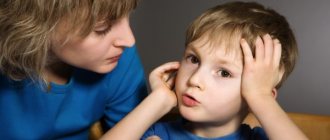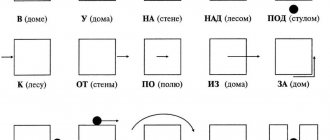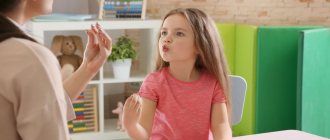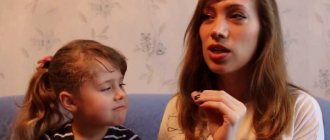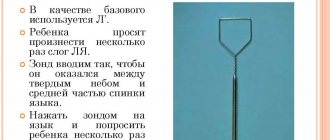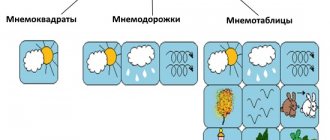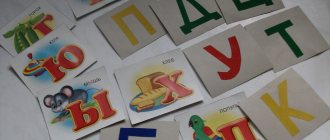Automating the sound P in sentences using mnemonics will help introduce the sound P into coherent speech. Often automation begins with a combination of sounds TR, DR. This position of sounds is often easier for the child
On our website you can also download visuals on automating the sound “R” in classes, games and exercises, tongue twisters, poems, and tongue twisters. All visual material is illustrated with pictures accessible to children.
Automation in sentences will also develop associative thinking and introduce prepositions. Each preposition is indicated schematically. The model of prepositions is presented below.
Remember:
- Each lesson should begin with a warm-up, these are 2-3 articulatory gymnastics ;
- then we move on to automation in syllables, words, phrases, sentences and other game exercises;
- If the child does not learn or it is difficult for him to complete new tasks, you can go back and consolidate the pronunciation on simpler material.
THE MAIN RULE OF AUTOMATING SOUNDS IS TO ACHIEVE THE CORRECT PRONUNCIATION.
The sound R should be rolling and sonorous: DR-R-R-R-R
Improving speech in the preparatory group of preschool educational institutions using tables
Unprepared preschoolers with poor, illiterate speech have difficulty mastering school knowledge. The oldest kindergarten students are a little less dependent on visualization than younger preschoolers. But mnemonic tables are still a necessary method of cognition.
Preparing speech for learning to read and write: mnemonics
Mnemonics help prepare a child to master literacy. The child practices constructing sentences and dividing them. It is worth considering the difficulties of the initial stages of working with pictures:
- the stories are unemotional and schematic;
- poor vocabulary;
- the sentences are fragmentary, uncertain, reminiscent of a tongue twister.
To neutralize difficulties, the teacher activates and enriches the vocabulary. Older preschoolers work with the material step by step:
- Parse the images.
- Symbols are transformed into images.
- Reproduce the text and make up an original story.
- Draw new mnemonic tables.
- The story is told according to diagrams created by the children.
You can create a table at home by selecting images on the topic
An example of an elementary manual on the topic “River”: the first picture is several waves; the second is a frog; the third is a fishing rod. Using this scheme, you can tell a couple of sentences or a whole fairy tale (older preschoolers).
Important! The content of didactic materials should be appropriate for the age of the children. It becomes more difficult gradually, without overload.
Mnemonic diagrams for speech development for preschoolers should be structured according to the program, exciting, and reflect the values of education. It is necessary to develop such benefits not only with children, but also with parents. They are introduced to technology at meetings and events. The teacher will receive like-minded people and associates who will make the mnemonic table method even more effective. The cooperation of the family with the teacher during the senior year is especially valuable.
What skills do preschoolers develop in dialogue?
Mnemonic tables for the preparatory group: reading, retelling
First, highlight the central idea of the text in all paragraphs. Icons are invented to convey this idea. For small texts, select 1 character for each word.
You can fill the diagram with the heroes of history, natural phenomena. It is worth putting into it what is difficult to remember.
Important! Effective drawings are easy to read and their meaning is clear.
Kids, in addition to drawings, master graphic symbols. An example of simple images in mnemonic tables for junior and middle groups: animals from a triangle (torso), a circle (head). Color accordingly. Complex symbols: black lines, circles, dots, checkmarks. Depending on their age, children can draw diagrams under the supervision of adults or just color them.
Using mnemonic tables for cognitive development
Cognitive development and the factors influencing it are considered by A. M. Leushina and other teachers. For the effectiveness of cognition, the following are important:
- visibility;
- drawing up a plan, sequential placement of components;
- entertaining game.
It’s easy to learn poems using charts and tables
These factors are combined in mnemonic tables, which are considered a visual plan of information. Kids come up with points and sequentially encode them in images. This is how poems are memorized, fairy tales are composed, the properties of new objects are studied, and information is systematized.
Exercise “Answer questions in complete sentences”:
- Who chops the wood?
- Where does the otter live?
- When do blackbirds fly south?
- How do you get water from a well?
- What do you put the yeast in?
- What can a dragon do?
Exercise “Continue the sentence following the example”:
- Katya enters the subway, and Kolya exits the subway.
- Vanya gets on the tram, and Dima...
- Tanya puts away the notebook, and Valya...
- Misha goes to the theater, and Petya...
- Nikolai sells the pipe, and Trofim...
- Masha sits down on the mattress, and Dasha...
- Dima climbs the springboard, and Tolya...
- Vova is digging a trench, and Vanya...
- Olya imitated the trumpet player, and Dima imitated the trumpet player.
- Tanya touched the wall, and Vanya...
- The willow was reflected in the water, and the birch...
- Nastya tore off the sheet, and Petya...
- Yulia was shivering from the cold, and Sasha...
- Dasha kicked her leg, and Misha...
Automation of the sound R in sentences combined with TR, DR using mnemonics:
- Grandfather gets off the trolleybus.
- Aunt Tonya is talking with a friend.
- Uncle Trofim is sitting behind a cedar tree.
- Peter has many friends.
- Trams go one after another.
- Three girlfriends are wearing snowflake costumes.
Automation of the sound R in sentences using mnemonics in a combination of consonants TR, DR will help introduce the sound R into coherent speech.
In addition to automating the sound R in sentences on our website, you can find material on automation in syllables, words, phrases, phrases, tongue twisters, stories and poems.
Consolidation in a playful way
Still, it is best if the automation of the “R” sound in words was carried out in the form of games. This will engage the child as much as possible and he won’t even notice how time passes and the pronunciation becomes automatic.
The first game exercise “What has changed?”
To play the game you will need to prepare different cards on which there are images with the letter “P” in their name. Then lay out 3 cards and ask the child what is drawn on them. If the child pronounces the sound incorrectly, you need to repeat it again. After all, the main goal of the lesson is not entertainment, but the automation of the sound “R” in words and phrases.
So, you will need to cover the cards with something and replace one. Then open them and ask the baby what drawing appeared and what it is called. As soon as the baby pronounces the word correctly, you can move on to other pictures and repeat the game.
If the child can easily remember 3 pictures, then it is necessary to increase their number, but no more than 8 pieces.
Second game session “Remember the order”
You can also use these same pictures for the next lesson. You will need to arrange them in a row, 5 pieces are enough. Let your child watch and remember them. Then ask him to turn away and name all the pictures in the order in which they are located.
If you make a mistake, you need to give it another chance and repeat the exercise. If you complete the task correctly and pronounce the names of the pictures, you need to change cards.
Third game exercise “Remember the most words?”
This game can be played anywhere, be it at home, on the bus or walking outdoors. You just need to compete to see who knows more words with the sound “R”.
There are quite a lot of such words and they appear at every step. As soon as you go outside, you can immediately name the yard, porch, tree, door, road, grass, and so on!
